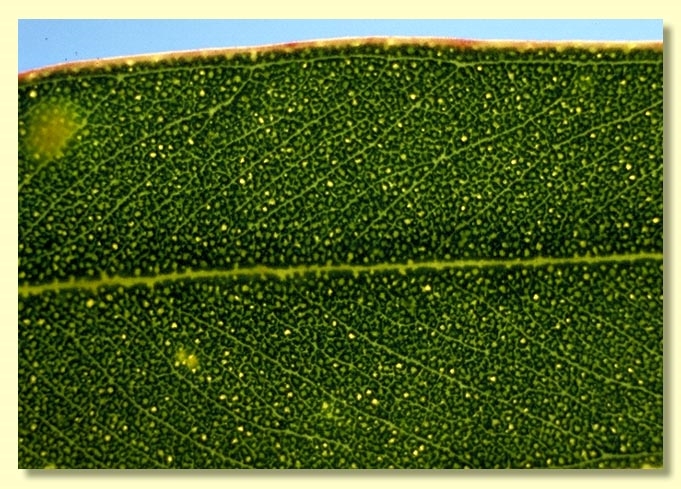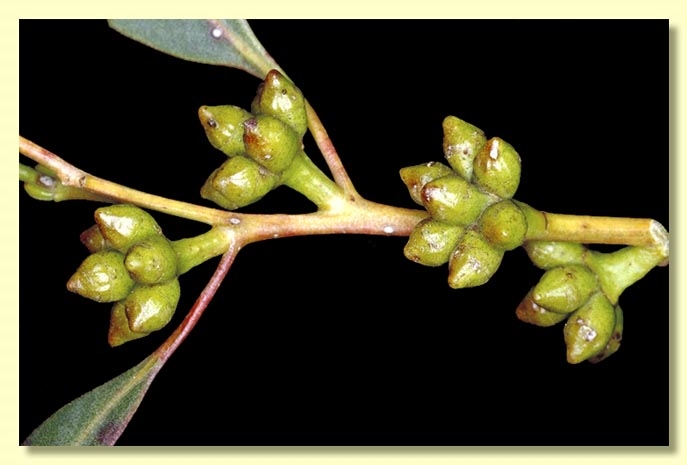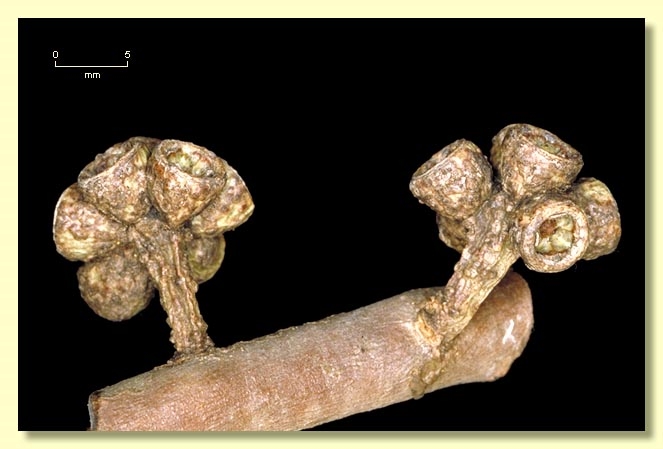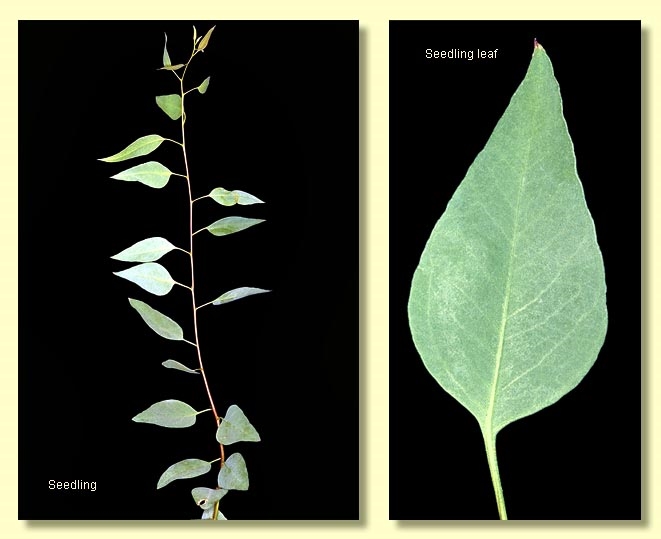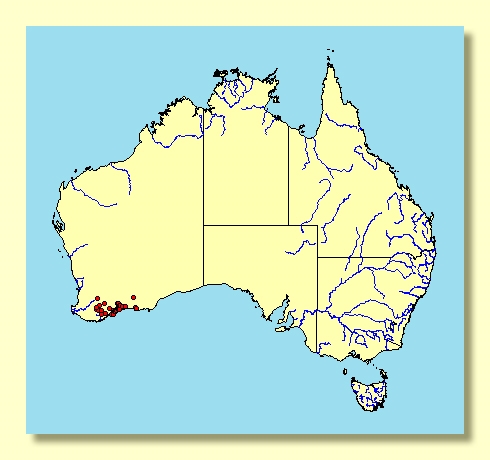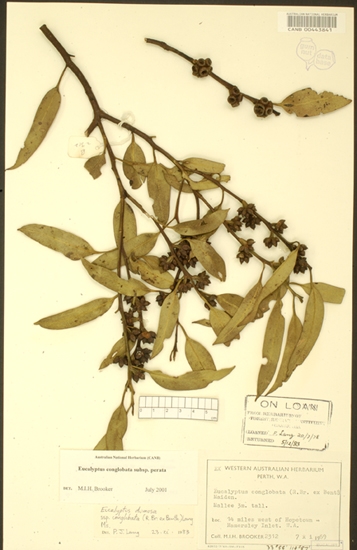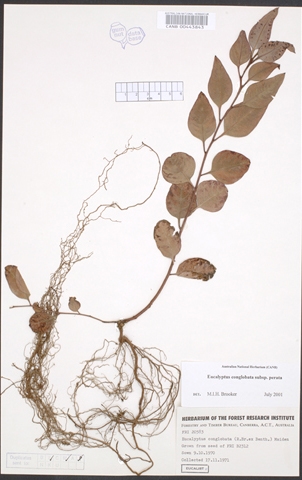Eucalyptus | Symphyomyrtus | Dumaria | Rufispermae
Euclid - Online edition
Eucalyptus conglobata subsp. perata
Eucalyptus conglobata subsp. perata Brooker & Slee, Nuytsia 15: 157 (2004).
T: Western Australia: 14 miles [23.5 km] west of Hopetoun towards Hamersley River (Fitzgerald River National Park), 7 Nov. 1969, M.I.H.Brooker 2312; holo: CANB; iso: PERTH.
Bark smooth throughout, shedding in short strips, pale grey over creamy white.
Branchlets with oil glands in the pith.
Juvenile growth (coppice or wild seedling to 50 cm tall): not seen.
Adult leaves alternate, petioles 1–2 cm long; blade lanceolate to narrowly lanceolate, 6.2–9(10) cm long, 0.8–1.5(2) cm wide, base tapering to petiole, concolorous, usually slightly glossy, olive green, side-veins greater than 45° to midrib, reticulation very dense, intramarginal vein close to margin, oil glands intersectional.
Inflorescence axillary unbranched, peduncles stout, 0.3–0.8 cm long, buds 7 per umbel, sessile, crowded. Mature buds ± ovoid (0.5–0.9 cm long, 0.4–0.6 cm wide), scar present, operculum usually conical (0.2–0.5 cm long), striate, stamens inflexed, anthers cuboid to wedge-shaped, versatile, dorsifixed, dehiscing by longitudinal slits (non-confluent), style long, stigma blunt, locules 4(5), the placentae each with 4 vertical ovule rows. Flowers white.
Fruit sessile, tightly clustered, cupular, 0.4–0.5 cm long, 0.5–0.7 cm wide, disc usually descending, valves 4(5), at rim level.
Seeds reddish brown and glossy, 1.1–2.2 mm long, flattened-ovoid and often slightly angular in outline, dorsal surface shallowly reticulate, occasionally lacunose, hilum ventral.
Cultivated seedlings (measured at ca node 10): cotyledons reniform; stems rounded or square in cross-section; leaves always petiolate, opposite for 3 or 4 nodes then alternate, ovate to broadly lanceolate, 4–8 cm long, 2–3 cm wide, dull, green to grey-green.
Flowering has been recorded in January, February and March.
Eucalyptus conglobata is a species of mallee or small tree, widespread along south coastal and subcoastal Western Australia, east to Toolinna Cove, and disjunctly in South Australia only on the southern Eyre Peninsula, including Boston Island near Port Lincoln. The bark is smooth, adult leaves dull blue-green maturing glossy green, buds and fruit sessile in umbels of seven.
In the classification of Brooker (2000) Eucalyptus conglobata belongs in Eucalyptus subgenus Symphyomyrtus section Dumaria having these features: buds initially with two opercula the outer shed early, stamens strongly inflexed, ovules in 4 rows on the placentae and cotyledons reniform. Within section Dumaria the species belongs to a large sub-group of closely related species (series Rufispermae, 37 described species and subspecies) diagnosed by glandular pith in the branchlets, anthers cuboid to wedge-shaped, versatile, and by the reddish brown and glossy, flattish seeds which are unique to the series.
Eucalyptus conglobata is distinguished in the series Rufispermae by the completely sessile buds and squat fruits, the latter often being wider than long. It is a variable species, in leaf width, peduncle length and bud and fruit size.
There are two subspecies:
E. conglobata subsp. conglobata
The typical coarse-leaved and stout-budded form with fruits 0.7–1.1 cm diameter, occurring on limy substrates near Port Lincoln in South Australia but also common in Western Australia from near Toolinna, Israelite Bay to Esperance and inland as far as Salmon Gums and Mt Ney. It grows to be a lignotuberous tree on Boston Island east of Port Lincoln.
E. conglobata subsp. perata.
This form, with much finer leaves and smaller buds, and fruits 0.5–0.7 cm diameter, is common throughout the Western Australian part of the species range west of Esperance. It has been collected in many places from Pingrup, Dumbleyung, Nyabing, Borden, Stirling Ranges, Jerramungup, Bremer Bay, Ravensthorpe Range, Fitzgerald River National Park.
The mallee subsp. conglobata is unlikely to be confused with any other species in the Port Lincoln area. In the Esperance hinterland there are several closely related species, viz. E. valens, which is a tree (mallet) with more glossy adult leaves, sessile buds and fruit very like subsp. conglobata in size; E. pileata, a mallee with umbels on peduncles to 1.5 cm long and pedicellate cylindrical to pyriform buds with operculum always wider than the base of the bud; E. spreta, a slender mallet often branching low, with small always pedicellate ovoid to cylindrical buds and cupular fruit to 0.7 cm diameter.
Subsp. perata is often confused with the closely related E. phenax subsp. phenax. Subsp. perata is weakly separated from E. phenax subsp. phenax in having consistently sessile ovoid buds (0.5-0.9 cm long), compared with the usually shortly pedicellate ovoid-cylindrical buds (0.7-1.1 cm long) of E. phenax subsp. phenax. To make it even more difficult these two taxa probably intergrade where their ranges abut e.g. north of Ravensthorpe.
subsp. perata: Latin peratus, western, alluding to its occurrence in relation to the subsp. conglobata.



